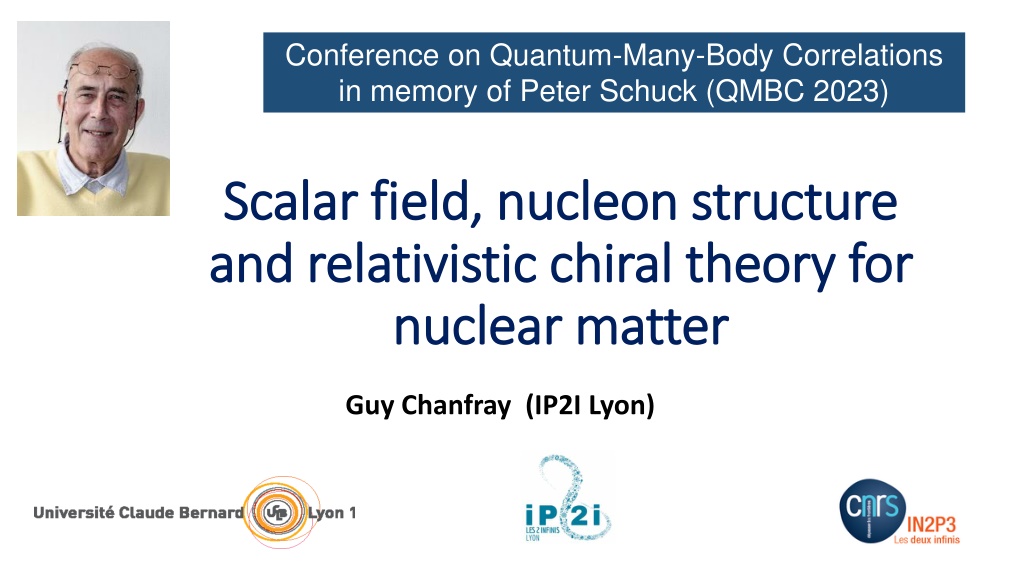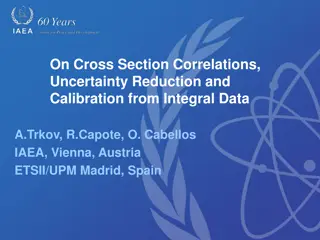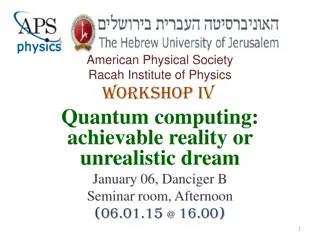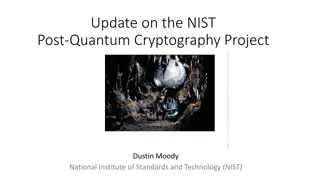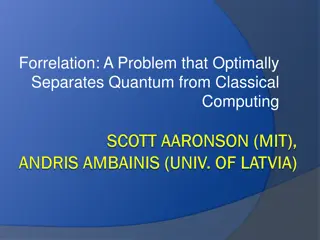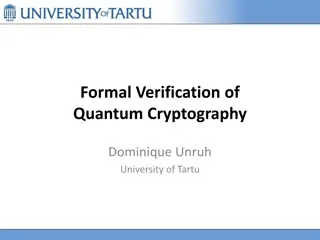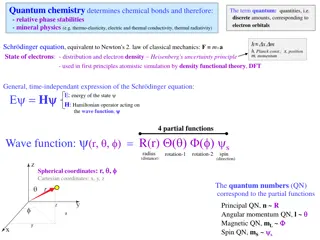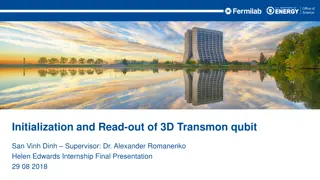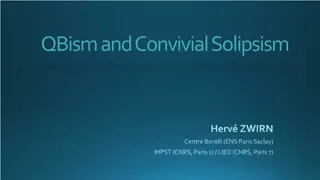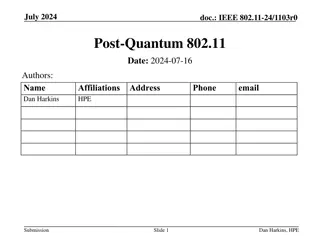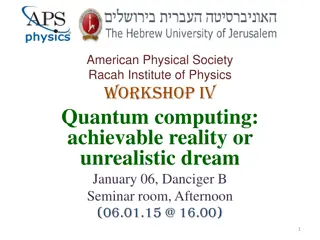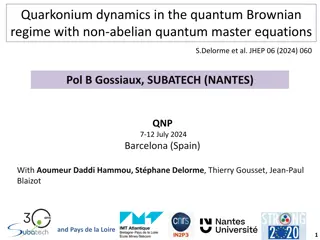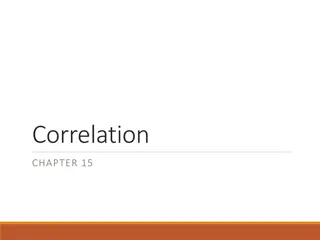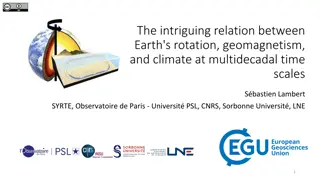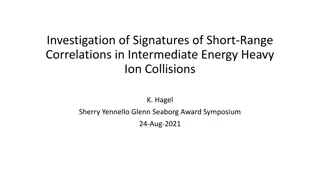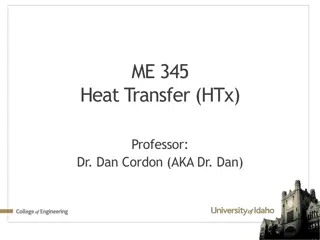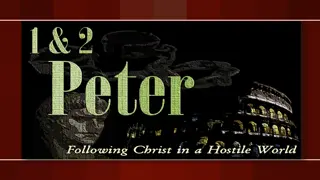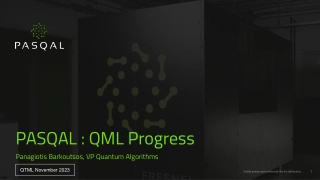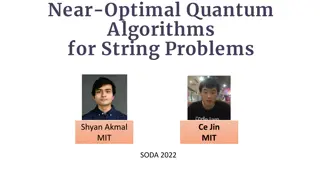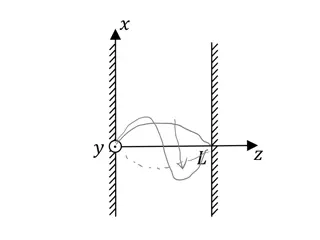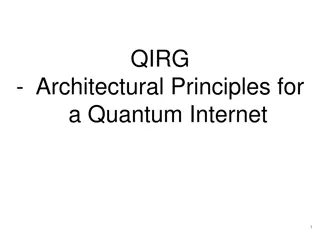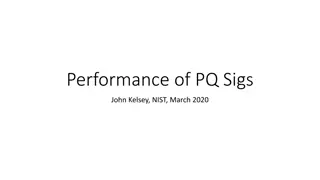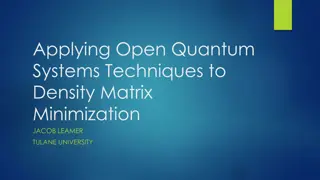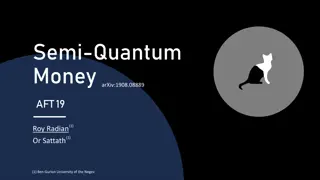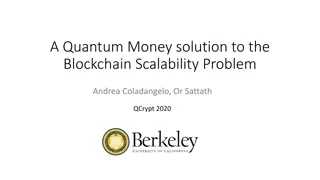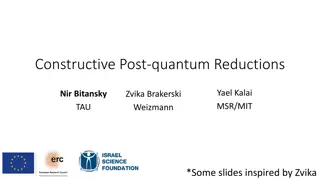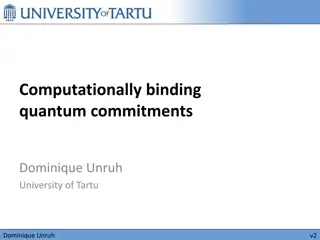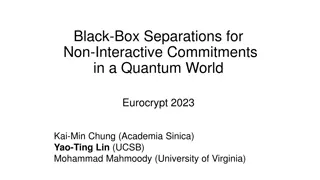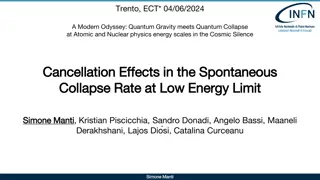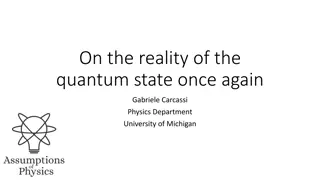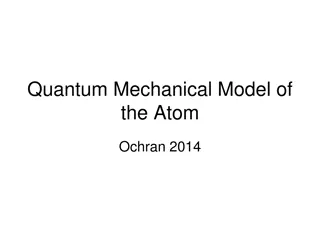Quantum Many-Body Correlations Conference: Remembering Peter Schuck (QMBC 2023)
Peter Schuck's contributions to nuclear physics, chiral theories, and collaborations with Lyon and Darmstadt groups in the study of quantum field theories are highlighted. His work on semi-classical techniques, neutrino-nucleus interactions, and medium-range attraction in scalar-isoscalar channels stand out as key accomplishments in the field. The collaborative efforts have led to significant advancements in understanding nuclear responses, spectral functions, and heavy-ion collisions.
Download Presentation

Please find below an Image/Link to download the presentation.
The content on the website is provided AS IS for your information and personal use only. It may not be sold, licensed, or shared on other websites without obtaining consent from the author. Download presentation by click this link. If you encounter any issues during the download, it is possible that the publisher has removed the file from their server.
E N D
Presentation Transcript
Conference on Quantum-Many-Body Correlations in memory of Peter Schuck (QMBC 2023) Scalar Scalar field and and relativistic relativistic chiral nuclear nuclear matter field, , nucleon nucleon structure chiral theory matter structure theory for for Guy Chanfray (IP2I Lyon)
My first memory of Peter Schuck is from 1986. His lecture at the Joliot Curie School He gave a lecture on "Dynamical treatment of symmetries: breaking and restoration" where he started with a little model", for the treatment of translational symmetry and the spurious mode. It was one of those petits mod les , pushed to the limit, preferably analytically, being able of extracting the maximum from them. In this lecture he also dealt with the question of chiral symmetry breaking in hadronic physics where the spurious mode or soft mode generated by its spontaneous breaking is associated with the pion, the Goldstone boson, and it is precisely at this time that Peter started, I think, to be interested in a more hadronic description of nuclear physics (what was called at the time intermediate energy physics).
Actually I can't remember exactly how and on what occasion I really came into contact with Peter, but I think that my motivation was primarily to use semi-classical techniques of which he was a great specialist for the calculation of nuclear responses of finite nuclei in the quasi- elastic domain, avoiding the full quantum calculation which is much too cumbersome and probably luxuous for the applications. This was the subject of our first common paper written in 1987 and published in PRA on the Wigner-Kirkwood hbar expansion of the RPA response function. The main application of these semi-classical techniques for our Lyon group came a few years later: the neutrino nuclei interaction, (thesis of Jacques Marteau, Peter was a member of the committee). This is largely thanks to this contribution that our team has been able to make a set of significant contributions to the neutrino-nucleus interaction, whose control is a key element for the analysis of long-base line neutrino oscillation experiments.
But very soon (1990) , the main subject of our collaboration was the question of the origin of the medium range attraction in the scalar-isoscalar channel by exchange of two pions coupled to the famous sigma meson introduced in relativistic theories. This led him, together with our group in Lyon and Jochen Wambach's group in Darmstadt, to a set of works : Linear sigma model and quantum field theories with broken symmetry using self- consistent RPA techniques (in particular the renormalized RPA version) Not only for models in hadronic physics but also for models that could describe the Higgs mechanism; this was Hubert Hansen's thesis work. It was in this context of collaboration that we were able to attract Micaela Oertel and Michael Urban, who were students of Jochen Wambach, to Lyon and Orsay. This also led to a paper in 1993 in which we predicted the finite density broadening of the spectral function in the channel of the rho meson in the production of dileptons in relativistic heavy ions, collisions, which was confirmed in a spectacular way a few years later by the CERES collaboration and especially by the Na60 collaboration.
In the beginning of the 90th, I published with P. Schuck a set of papers concerning the in-medium modification of the ?? interaction and of the associated resonances: the rho meson and the sigma meson Broadening of the rho in dense matter G.C., P. Schuck, (1992) +direct coupling of the rho to resonances NA60
Then came two related questions: 1. Do these spectacular medium effects affect the exchange of the sigma meson in nuclear matter? 2. What is the relationship with the nuclear physics sigma meson of relativistic Walecka theory? Nucleons exchange not only the sigma meson (the chiral partner of the pion) but also 2? states with delicate compensations: It is much more economical to express the scalar NN exchange in terms of the the radial mode which is free of many body effects and decouples from 2? states G. Chanfray, D. Davesne, M. Ericson, M. Martini, Eur. Phys. J. A27, 191 (2006) We identify the nuclear physics sigma meson with the chiral invariant field: ? = ? ?? associated to the radial fluctuation of the chiral condensate around the "chiral radius" .
But two major problems 1-Nuclear matter stability: Unavoidable consequence of the chiral effective potential (mexican hat): attractive tadpole Collapse of nuclear matter Dropping of Sigma mass s s s s s s (Bentz, Thomas) 2-Nucleon structure: the scalar susceptibility of the nucleon Lattice data analysis (Leinweber, Thomas, Young, Guichon) a2 : related to the non pionic piece of the sigma term a4: related to the scalar susceptibility of the nucleon: from lattice data essentially compatible with zero To be compared with Cure: Nucleon structure effect and confinement mechanism
The phenomenological (now called) chiral confining model The simplest Yukawa couplings Lagrangian Generates a Bonn-like NN potential No ad-hoc density dependent coupling constant Chiral effective potential with attractive tadpole diagram (L?M) Nucleon susceptibility ??? describing the nucleon respose to the nuclear scalar field
Saturation mechanism ??2 2?? Dimensionless response parameter ? = ??? ~ 0.5 1 3 Three-body force: ?(3) ?? 2 ?? ?? ???? ? 1 ?= 4 2 Lattice constraints ?4=???? ?? ???? ? 3?2=???? 2 4 2 2?? ?? G. Chanfray, M.Ericson and P.A.M Guichon, P.RC 63, 055202 (2001) G. Chanfray and M.Ericson, Eur. Phys. J. A 25, 151 (2005) G. Chanfray and M.Ericson, Phys. Rev. C 75, 015206 (2007) E. Massot and G. Chanfray, Phys. Rev. C 78, 015204 (2008). E. Massot and G. Chanfray, Phys. Rev. C 80, 015202 (2009). G. Chanfray and M.Ericson, Phys. Rev. C 83, 015204 (2011) E. Massot, J. Margueron, G. Chanfray, Europhys. Lett. 97, 39002 (2012). R. Somasundaram, J. Margueron, H. Hansen, G.C, EPJA 58, 84 (2022). Nuclear matter properties, chiral properties Important role of the Fock terms (consistently incorporated at the level of the self-energies and total energy) limiting the maximum mass of hyperonic star Bayesian analysis ?~1.4
The NJL chiral confining model Problem: One cannot find a nucleon model able to generate the very large value ? = 1 1.5 required by lattice data. L?? probably too naive : use an enriched chiral effective potential from a model giving a correct low energy realization of the broken chiral symmetry:The NJL model Parameters : ?1,?2 ,?, Bosonisation (quarks in the Dirac sea integrated out) produces a lagrangian where the meson fields ?????? ?,??, ??, ??are coupled to the constituent quarks. The vacuum value of the scalar field ? coincides with the vacuum value of the constituent quark mass ?0~350 ??? ? =?0 ?? s is the nuclear physics sigma meson ? + ?? ??= ?.? ?.? lattice data (small value of ?? ) become compatible with models value for ? while preserving the strong compensation effect needed for the saturation mechanism 3 ?(3) ? ?? ???? ? +?? ?? = 2 ??42 1 ? ?? ???? ? +? ?? ?4=???? 2??42 3 ?
The QCD-connected chiral confining model Physical picture : nucleon Y shaped string with constituent quarks at the ends moving in a in-medium modified broken vacuum Field Correlator Method (FCM): gluon averaging in the QCD partition function : effective non perturbative interaction mediated by a gluon correlator ?2 4??2 with ??= ?3?2 From lattice String tension: ? = 0.18 ???2 Gluon condensate: ?2= 0.025 ???4 String width: ??= 0.29 ?? ? 9? ? ? = 2???2 ??? ????(?) ?????(?) Shift _ ?/?? R/?? ~ equivalent to a NJL interaction Quadratic = 12.5 ??? 2 Linear 1 ??= 600 Mev ~
Solve Dirac equation for a constituent quark of mass ?0 moving in the confining potential and calculate the nucleon mass QCD-connected model Input for nuclear matter calculation Hadron phenomeniogy NN interaction Three body forces ? = ?.?? Short range correlation : pair correlation function : ? ? = ? ??(???) From adapted G matrix calculation preserving UV regularization
EOS: RMF calculation + pion-rho loops screened by SRC (g +h )(q) in RPA ring approximation Using Peter sGreen s function techniques Before any kind of fine tuning or adjustment, ????= 0.168 ?? 3 H. Hansen, J. Margueron, (M. R. Somasundarum,) M. Chamseddine, GC Systematic Bayesian analysis (RMF, RHF, Relativistic correlation energy ) and compare with RHF with density dependent couplings for the NEP Finite nuclei Asymmetric nuclear matter Transition to quark matter with percolation criteria
